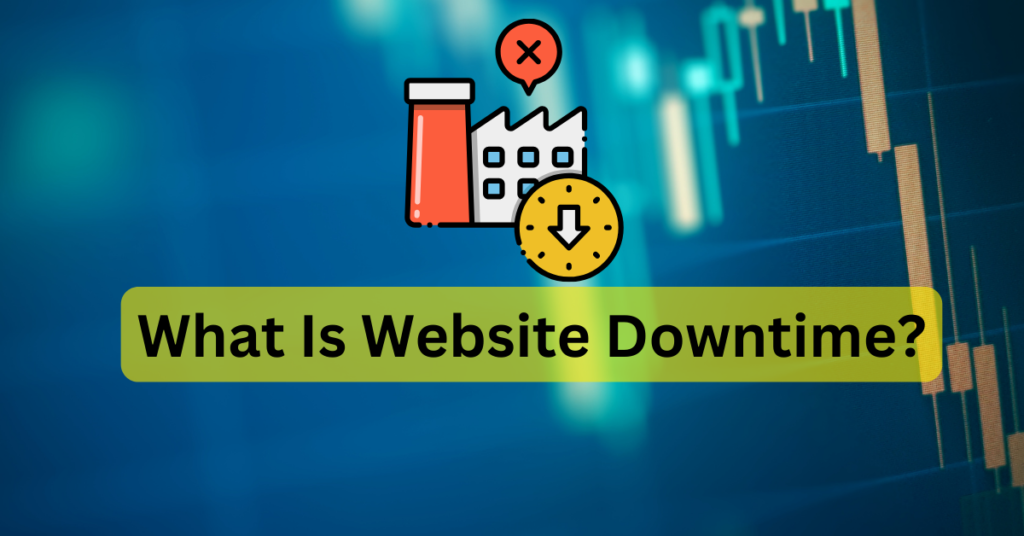Last Updated on June 7, 2024 by janetjacksondigital

The downtime of a website can be a major issue for businesses, ranging from lost sales and a damaged reputation, to bad user experience and low ranking in search engines. We’ll discuss the causes of website downtime the most common cause as well as the impact it has on businesses and the best practices to ensure websites’ uptime.
What Is Website Downtime?
Website Downtime on a occurs the time when a website or web service is not accessible or functioning properly for the users. There are two types of downtime: when a website is not accessible in any way (inaccessibility) or when the site is accessible but a portion of it does not function (partial time of downtime). Downtime is a temporary issue that impacts websites that ought to be functioning normal.
⏩Read also: What is website downtime & how it influences Seo?
What Does Not Count as Downtime
It’s possible that some things appear like the time to be down, but they’re not.
- Websites that are closed permanently or damaged
- Websites that say “down for maintenance” on the basis of
- The website may not be working due to poor coding or programming
Subjective Nature of Downtime
The definition of”downtime” has evolved in the course of time. The users are more comfortable with the website going down completely as opposed to a site where certain features are not working.
Here are a few examples of how a downtime might appear to be:
- The website is not working if customers cannot shop online and add products to the carts
- A website that loads slow can be deemed to be as down if it impacts the user experience
Common Reasons for Website Downtime
There are a variety of reasons websites can experience downtime. Some of the most frequent reasons are:
Human Error
One of the most common causes of downtime on websites is simply human error. This could include an error made by a developer in their code, an administrator updating the incorrect DNS entry or an employee erroneously closing down the server. A minor error could result in major problems. The year 2017 saw a significant AWS downtime which affected numerous websites was triggered by an unintentional typo during maintenance.
Hardware Failure and Maintenance
Every piece of hardware becomes worn out and eventually breaks. Servers are prone to fail at any time and cause downtime when the website ceases to be accessible. A regular maintenance schedule and back-up systems is crucial to reduce the effects. In the year 2010 Amazon had a massive interruption caused by an issue with their hardware in one of its data centers.
Malicious Attacks and DDoS
Cybercriminals and hackers can cause a downtime through attacks on servers and websites. One of the most common tactics is an Distributed Denial of Service (DDoS) attack that tries to overload and destroy servers by flooding them with data from multiple computers. The result is that real users are prevented from accessing the website. Other malware-related attacks can include things such as DNS redirection, SSL certification compromise or putting malicious software on servers.
Legitimate Traffic Spikes and Server Overload
Sometimes, downtime is due to too many good things. If a website experiences massive increases in users, possibly because of a product that has gone viral or being mentioned on the news, servers might not be able to take on the demand and may experience a crash in the process. This is more likely when smaller websites don’t have a robust infrastructure in place.
Software Issues and Compatibility
Software problems with the website could possibly be the source of the outage. The use of outdated software with security vulnerabilities can be a threat. The conflict between software tools or versions can cause the system to malfunction. Like human error glitches, bugs and errors in programming can cause a site to crash.
Network and Connectivity Problems
Since websites rely on a complicated network infrastructure for access via the internet, problems caused by the network may result in delays. It could be due to an issue with DNS issues, the DNS failing to translate the domain’s name properly or problems with routing between networks, or a weak link between the internet server and backbone of the internet. Connection between the web server and user’s device can also be a possible failure point.
Natural Disasters and Power Outages
At the end of the day, websites are run on hardware that is susceptible to interruptions from the real world. Natural disasters like hurricanes earthquakes, floods and flooding can cause data centers to be destroyed. The loss of power due to malfunctions in the grid or accidents could make servers unavailable. Backup and redundant power systems at other places is essential to ensure the availability of servers in case of catastrophes.
Impact of Website Downtime
The downtime of websites can cause major harm to companies. It affects reputation, sales as well as user experience as well as search engine rankings and also productivity.
Business and Reputation Impact
If a website’s performance is affected it won’t be able to make sales. Consumers who had intended to make a purchase are probably going to abandon their trolleys. If a site is large enough to be an e-commerce one just a few minutes of downtime can mean several thousand dollars of lost sales.
A downtime can also make a poor impression on prospective customers. If the most important features, such as search and add to cart fail users may think the entire site is not of high-quality. As time passes, a time-span of downtime can damage the online reputation of a brand.
User Experience Impact
Internet users don’t like waiting. Studies have shown that 40% of them will abandon a website in the event that it takes longer than three minutes to open. Therefore, a site that’s offline is likely to lose nearly all of its visitors.
Even when things aren’t working properly, a little downtime can make for a bad user experience. Frustration and a loss of confidence may result from this. A lot of users who experience an unpleasant experience will not be able to return.
Search Engine Optimization and Rankings
The goal of Search Engine Optimization is to point users toward reliable websites. If a site experiences lots of downtime the search engines may lower its rank or even remove it completely from the results.
The downtime of a site can also cause group buy SEO tools issues such as broken links or error pages. If a website isn’t available when a engine attempts to index it, then the website isn’t indexed or displayed in the search results.
Productivity Loss and Employee Frustration
For businesses, the downtime of their websites hinders employees to complete their work. The materials, information, and resources are not all accessible through the website.
If the downtime continues to occur it can be very stressful for the team members. Productivity and morale decline. Poor customer service has an impact on the bottom line.
In the end, downtime on websites is a serious threat. It can affect the marketing, sales, operations and even customer satisfaction. This is why it’s crucial for websites to be secure with secure host and monitoring to prevent interruptions in service.
Measuring and Tracking Website Uptime
The measurement and tracking of website uptime is essential to know the performance and reliability of your site. Through monitoring the uptime of your website you will be able to identify problems quickly, minimize downtime and improve the experience for visitors.
SLAs, or service level agreements
Service Level agreements (SLAs), which outline the expected level of service in their offers, are offered by many hosting firms. SLAs are contracts which specify the minimum percentage of uptime that the provider will guarantee.
If the service provider does not fulfill the time-to-uptime SLA the customers could be eligible to receive credits or penalties in exchange for downtime. It is crucial to keep track and keep track of SLAs to ensure that the service is fulfilling their obligations and be compensated appropriately when they fail to comply with the requirements. When deciding on a hosting service be sure to check the SLA obligations.
Incident Reporting and Analysis
When a website is down it is crucial to develop thorough incident reports that detail the reason of the outage, its duration, and the effects of the outage. The reports must include:
- The timeline of this incident
- Analysis of root causes
- The steps taken to correct the problem
- Steps to avoid similar events from happening again in the future.
In analyzing the duration and frequency of downtime events in time, you are able to discover trends and areas of improvements to your website’s infrastructure and procedures.
Best Practices for Maintaining Website Uptime
To prevent website downtime, you must take an active approach and the implementation of the best practices. Here are some ways to reduce downtime and making sure your website is available and functioning well for your users:
Regularly Testing and Monitoring
One of the most crucial methods to ensure that your website is up and running is testing and monitoring regularly your website’s performance and availability. Make use of an web-based monitoring tool such as uptimia to keep track of your website’s performance from various places around the globe.
Website monitoring tools can notify you instantly if your site is down or has problems with performance, allowing you to swiftly investigate and solve issues. Automated testing also helps to identify problems that manual testing may overlook, like frequent issues or slow loading of pages.
25+ Social Media Best Practices to Follow in 2024
Keeping Software and Hardware Up to Date
Another crucial aspect to keep is to ensure that the hardware and software components current. This includes operating system, the web server database, database, plugins, content management system as well as any other software your website is dependent on.
Applying security patches regularly and ensuring that you are up-to-date with the latest stable versions will help to avoid compatibility issues as well as protect against weaknesses that can be exploited to take your website offline. While keeping up-to-date with updates is lengthy, it is vital for maintaining your website’s performance and security.
It is worth automating updates to software and patches when it is possible to improve the efficiency of maintenance without sacrificing quality. A lot of hosting providers and CMS systems have tools that can simplify the process of updating.
Implementing a Content Delivery Network (CDN)
Implementing the use of a Implementing a Content Delivery Network (CDN) can help improve the speed of your website’s performance. A CDN is a way to distribute your website’s content through a network of servers located in various geographical areas.
When a visitor requests the page on your site When a user visits your website, the CDN serves the content on the nearest server, thus reducing the distance data needs to travel as well as the load placed on your server. This will significantly reduce the speed of loading pages and reduce downtime due to the increase in traffic or overload on servers.
Apart from improving speed in addition to enhancing performance, the CDN can also offer an additional layer of security against DDoS attacks as well as other dangers by absorbing and filtering unwanted traffic before it can reach your site. Implementing CDNs CDN is usually cost-effective to increase the speed and performance of your website without having to purchase more infrastructure.
Other top practices to ensure the website’s uptime are:
- Choose a reputable web hosting service provider that has the performance record in uptime
- Implementing failover and redundancy mechanisms for vital components
- The development of the most comprehensive disaster recovery strategy
- Backup regularly of website data and configurations
- Optimizing web code and resources to improve performance
- Monitoring the website logs and analytics for trends and issues.
Key Takeaways
- The human error of a computer, the hardware malfunction and malicious attacks spikes in traffic and software issues and network issues natural disasters are all common reasons for website downtime.
- The impact of downtime on businesses can be significant through loss of sales, damaged reputation, bad user experience, lower rankings for engines, and decrease in productivity.
- Monitoring and calculating the percentage of uptime downtime, minutes of downtime, as well as service level agreements (SLAs) helps to understand the reliability of websites and their performance.
- Monitoring, testing, and regularly upgrading hardware and software and implementing an online Content delivery network (CDN) and selecting a reliable host are the best ways to avoid interruptions to your website.

My name is Janet Jackson Seo and I work as a SEO Expert. I appreciate the process of developing an innovative approach and employing logic, particularly when it concerns future studies and SEO optimization. As an SEO expert I have known how to set up SEO campaigns fully and how to monitor their achievements.





